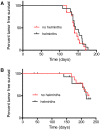Hymenolepis diminuta-based helminth therapy in C3(1)-TAg mice does not alter breast tumor onset or progression
- PMID: 33738103
- PMCID: PMC7953836
- DOI: 10.1093/emph/eoab007
Hymenolepis diminuta-based helminth therapy in C3(1)-TAg mice does not alter breast tumor onset or progression
Abstract
Background and objectives: An individual's risk of breast cancer is profoundly affected by evolutionary mismatch. Mismatches in Western society known to increase the risk of breast cancer include a sedentary lifestyle and reproductive factors. Biota alteration, characterized by a loss of biodiversity from the ecosystem of the human body as a result of Western society, is a mismatch known to increase the risk of a variety of inflammation-related diseases, including colitis-associated colon cancer. However, the effect of biota alteration on breast cancer has not been evaluated.
Methodology: In this study, we utilized the C3(1)-TAg mouse model of breast cancer to evaluate the role of biota alteration in the development of breast cancer. This model has been used to recapitulate the role of exercise and pregnancy in reducing the risk of breast cancer. C3(1)-TAg mice were treated with Hymenolepis diminuta, a benign helminth that has been shown to reverse the effects of biota alteration in animal models.
Results: No effect of the helminth H. diminuta was observed. Neither the latency nor tumor growth was affected by the therapy, and no significant effects on tumor transcriptome were observed based on RNAseq analysis.
Conclusions and implications: These findings suggest that biota alteration, although known to affect a variety of Western-associated diseases, might not be a significant factor in the high rate of breast cancer observed in Western societies.
Lay summary: An almost complete loss of intestinal worms in high-income countries has led to increases in allergic disorders, autoimmune conditions, and perhaps colon cancer. However, in this study, results using laboratory mice suggest that loss of intestinal worms might not be associated with breast cancer.
Keywords: breast cancer; evolutionary mismatch; helminth therapy; hygiene hypothesis; mouse model.
© The Author(s) 2021. Published by Oxford University Press on behalf of the Foundation for Evolution, Medicine, and Public Health.
Figures



Similar articles
-
The benign helminth Hymenolepis diminuta ameliorates chemically induced colitis in a rat model system.Parasitology. 2018 Sep;145(10):1324-1335. doi: 10.1017/S0031182018000896. Epub 2018 Jun 18. Parasitology. 2018. PMID: 29909781
-
Production of Hymenolepis diminuta in the Laboratory: An Old Research Tool with New Clinical Applications.Methods Mol Biol. 2018;1799:27-38. doi: 10.1007/978-1-4939-7896-0_3. Methods Mol Biol. 2018. PMID: 29956141
-
Cooperation between host immunity and the gut bacteria is essential for helminth-evoked suppression of colitis.Microbiome. 2021 Sep 13;9(1):186. doi: 10.1186/s40168-021-01146-2. Microbiome. 2021. PMID: 34517928 Free PMC article.
-
Intestinal worms eating neuropsychiatric disorders? Apparently so.Brain Res. 2018 Aug 15;1693(Pt B):218-221. doi: 10.1016/j.brainres.2018.01.023. Epub 2018 Feb 2. Brain Res. 2018. PMID: 29402395 Review.
-
Reevaluating Biota Alteration: Reframing Environmental Influences on Chronic Immune Disorders and Exploring Novel Therapeutic Opportunities.Yale J Biol Med. 2024 Jun 28;97(2):253-263. doi: 10.59249/VUNF1315. eCollection 2024 Jun. Yale J Biol Med. 2024. PMID: 38947109 Free PMC article. Review.
Cited by
-
Mining parasites for their potential as novel therapeutic agents against cancer.Med Oncol. 2024 Jul 29;41(9):211. doi: 10.1007/s12032-024-02458-7. Med Oncol. 2024. PMID: 39073638 Review.
-
The Tapeworm Hymenolepis diminuta as an Important Model Organism in the Experimental Parasitology of the 21st Century.Pathogens. 2022 Nov 29;11(12):1439. doi: 10.3390/pathogens11121439. Pathogens. 2022. PMID: 36558772 Free PMC article. Review.
-
Inhibition Effects of Nippostrongylus brasiliensis and Its Derivatives against Atherosclerosis in ApoE-/- Mice through Anti-Inflammatory Response.Pathogens. 2022 Oct 20;11(10):1208. doi: 10.3390/pathogens11101208. Pathogens. 2022. PMID: 36297265 Free PMC article.
-
How tapeworms interact with cancers: a mini-review.PeerJ. 2024 Mar 29;12:e17196. doi: 10.7717/peerj.17196. eCollection 2024. PeerJ. 2024. PMID: 38563013 Free PMC article. Review.
References
-
- Bickler SW, DeMaio A.. Western diseases: current concepts and implications for pediatric surgery research and practice. Pediatr Surg Int 2008; 24:251–5. - PubMed
-
- Pontzer H, Wood BM, Raichlen DA.. Hunter-gatherers as models in public health. Obes Rev 2018; 19:24–35. - PubMed
-
- Breast Cancer. https://www.who.int/cancer/prevention/diagnosis-screening/breast-cancer/en/ (20 July 2020).
Grants and funding
LinkOut - more resources
Full Text Sources
Other Literature Sources
Miscellaneous

